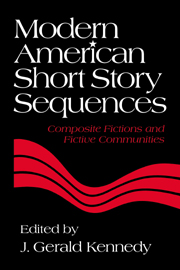Book contents
- Frontmatter
- Contents
- Contributors
- Introduction: The American Short Story Sequence – Definitions and Implications
- Henry James's Incipient Poetics of the Short Story Sequence: The Finer Grain (1910)
- Toomer's Cane as Narrative Sequence
- Hemingway's In Our Time: The Biography of a Book
- Wright Writing Reading: Narrative Strategies in Uncle Tom's Children
- The African-American Voice in Faulkner's Go Down, Moses
- Meditations on Nonpresence: Re-visioning the Short Story in Eudora Welty's The Wide Net
- Nine Stories: J. D. Salinger's Linked Mysteries
- Cheever's Shady Hill: A Suburban Sequence
- John Updike's Olinger Stories: New Light Among the Shadows
- Louise Erdrich's Love Medicine: Narrative Communities and the Short Story Sequence
- From Anderson's Winesburg to Carver's Cathedral: The Short Story Sequence and the Semblance of Community
- Index
The African-American Voice in Faulkner's Go Down, Moses
Published online by Cambridge University Press: 29 September 2009
- Frontmatter
- Contents
- Contributors
- Introduction: The American Short Story Sequence – Definitions and Implications
- Henry James's Incipient Poetics of the Short Story Sequence: The Finer Grain (1910)
- Toomer's Cane as Narrative Sequence
- Hemingway's In Our Time: The Biography of a Book
- Wright Writing Reading: Narrative Strategies in Uncle Tom's Children
- The African-American Voice in Faulkner's Go Down, Moses
- Meditations on Nonpresence: Re-visioning the Short Story in Eudora Welty's The Wide Net
- Nine Stories: J. D. Salinger's Linked Mysteries
- Cheever's Shady Hill: A Suburban Sequence
- John Updike's Olinger Stories: New Light Among the Shadows
- Louise Erdrich's Love Medicine: Narrative Communities and the Short Story Sequence
- From Anderson's Winesburg to Carver's Cathedral: The Short Story Sequence and the Semblance of Community
- Index
Summary
On a riverbank in the cool of a summer evening two women struggled under a shower of silvery blue. They never expected to see each other again in this world and at the moment couldn't care less. But there on a summer night surrounded by bluefern they did something together appropriately and well.
Toni Morrison, Beloved (1987)Nearly thirty years ago, in The Achievement of William Faulkner, Michael Millgate argued that the aesthetic unity of Go Down, Moses resulted from Faulkner's successful representation of “the white-Negro theme.” Like other literary formalists of his generation, Millgate focused on a “theme” notable for its tension and conflict, in order to show how the literary work effects “the conjunction, and in some measure the fusion, of a number of disparate ideas” (201). For Millgate, this aesthetic synthesis depends crucially on the character of Ike McCaslin, “whose combination of sensitivity and long life would afford scope for the two complementary strategies of innocent childhood and retrospective old age” (201). More than simply anchoring the thematic tensions of Go Down, Moses, Ike embodies them in a complex character that serves as an ironic patriarch for a new, redeemed South. Ike may never “father” the “new family” that would transform the conflicts of Southern whites and African Americans into an openly miscegenated family, but this is surely what Faulkner claims for himself as author in dramatizing the twinned fates of the whites and African Americans of the McCaslin family as the central action of Go Down, Moses.
- Type
- Chapter
- Information
- Modern American Short Story SequencesComposite Fictions and Fictive Communities, pp. 76 - 97Publisher: Cambridge University PressPrint publication year: 1995
- 10
- Cited by



